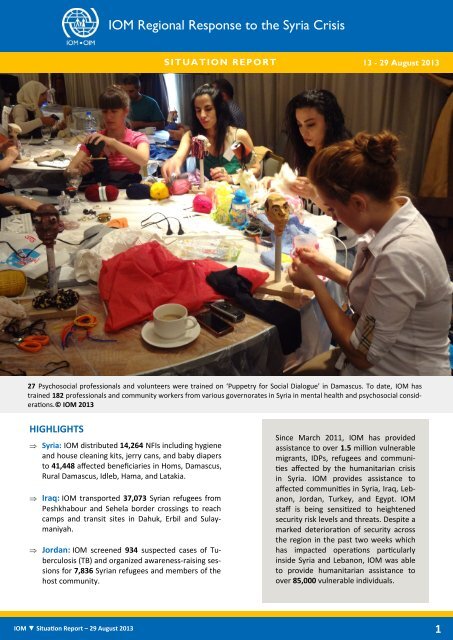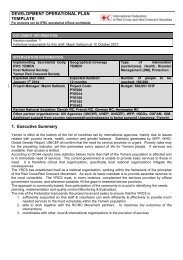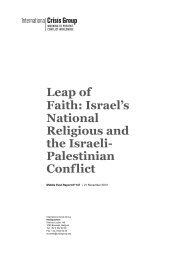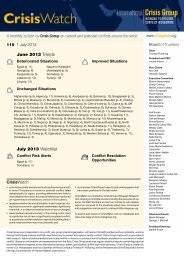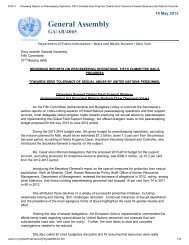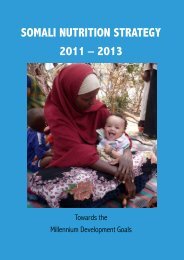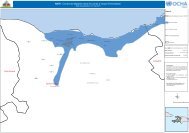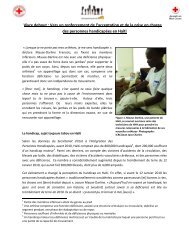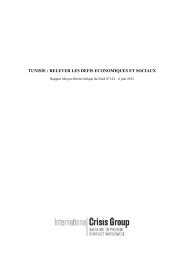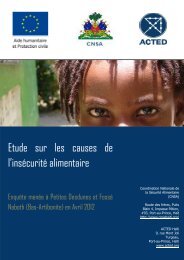Download PDF (3.04 MB) - ReliefWeb
Download PDF (3.04 MB) - ReliefWeb
Download PDF (3.04 MB) - ReliefWeb
You also want an ePaper? Increase the reach of your titles
YUMPU automatically turns print PDFs into web optimized ePapers that Google loves.
IOM Regional Response to the Syria Crisis<br />
IOM Regional Response to the Syria Crisis<br />
SITUATION REPORT<br />
131 - February 29 August 2013<br />
27 Psychosocial professionals and volunteers were trained on ‘Puppetry for Social Dialogue’ in Damascus. To date, IOM has<br />
trained 182 professionals and community workers from various governorates in Syria in mental health and psychosocial considerations.©<br />
IOM 2013<br />
HIGHLIGHTS<br />
Syria: IOM distributed 14,264 NFIs including hygiene<br />
and house cleaning kits, jerry cans, and baby diapers<br />
to 41,448 affected beneficiaries in Homs, Damascus,<br />
Rural Damascus, Idleb, Hama, and Latakia.<br />
Iraq: IOM transported 37,073 Syrian refugees from<br />
Peshkhabour and Sehela border crossings to reach<br />
camps and transit sites in Dahuk, Erbil and Sulaymaniyah.<br />
Jordan: IOM screened 934 suspected cases of Tuberculosis<br />
(TB) and organized awareness-raising sessions<br />
for 7,836 Syrian refugees and members of the<br />
host community.<br />
Since March 2011, IOM has provided<br />
assistance to over 1.5 million vulnerable<br />
migrants, IDPs, refugees and communities<br />
affected by the humanitarian crisis<br />
in Syria. IOM provides assistance to<br />
affected communities in Syria, Iraq, Lebanon,<br />
Jordan, Turkey, and Egypt. IOM<br />
staff is being sensitized to heightened<br />
security risk levels and threats. Despite a<br />
marked deterioration of security across<br />
the region in the past two weeks which<br />
has impacted operations particularly<br />
inside Syria and Lebanon, IOM was able<br />
to provide humanitarian assistance to<br />
over 85,000 vulnerable individuals.<br />
IOM ▼ Situation Report – 29 August 2013<br />
1
IOM<br />
OPERATIONS<br />
IN SYRIA<br />
Non-Food Item (NFI) Distribution:<br />
From 13 to 27 August,<br />
IOM distributed 14,264 NFIs<br />
including hygiene and house<br />
cleaning kits, jerry cans, and<br />
baby diapers to 41,448 affected<br />
beneficiaries in Homs, Damascus,<br />
Rural Damascus, Idleb, Hama,<br />
and Latakia. IOM staff<br />
worked alongside representatives<br />
from Orthodox Charity,<br />
Syria Trust, Al Faihaa Association,<br />
and Syrian Arab Red Crescent<br />
(SARC) to ensure quick and<br />
efficient delivery of assistance<br />
to the most vulnerable beneficiaries. On 26 August,<br />
distributions in Rural Damascus were cancelled due to<br />
insecurity.<br />
IOM is finalizing the rehabilitation of a warehouse in<br />
Tartous. IOM will preposition items in Tartous to assist<br />
the Organization to respond quickly and effectively to<br />
needs reported in the area. Tartous, is a port city, located<br />
in close proximity to the Syrian-Lebanese border.<br />
Since January 2013, IOM has assisted over 277,472<br />
IDPs in 12 governorates in Syria through the provision<br />
of 89,307 NFI kits including mattresses, blankets, cleaning<br />
items, insecticides, baby diapers, kitchen sets, underwear,<br />
jerry cans, and disability support items. IOM<br />
plans to reach 500,000 IDPs by the end of 2013.<br />
Psychosocial Support to Affected Communities: IOM<br />
provides operational assistance and training to increase/build<br />
the capacity of professionals and volunteers<br />
to provide psychosocial support to people affected<br />
by the crisis in Syria.<br />
During the reporting period, IOM staff ran 2 workshops:<br />
Since July, IOM has trained 102 shelter managers in Damascus, Rural Damascus, Tartous,<br />
and Homs. © IOM 2013 (Photo: IOM Syria)<br />
· Training on Art-Based Interventions (21 – 25 August):<br />
IOM, with the support of the Syrian Society for Social<br />
Development (SSSD) trained 27 professionals<br />
and volunteers on ‘Puppetry for Social Dialogue’ in<br />
Damascus. The participants were from the SSSD,<br />
the Children Culture Directorate, Ministry of Education,<br />
SARC, Faculty of Education, Terre Des<br />
Hommes (TDH), International Medical Corps (IMC),<br />
UNRWA, Greek Orthodox Patriarchate of Antioch<br />
(GOPA), Danish Refugee Council (DRC), volunteers<br />
from Good Sheperd NGO and local community volunteers<br />
from Damascus, Homs, and Quamishly.<br />
After the training, participants commented that<br />
they were now equipped to use puppetry as a<br />
counseling medium and they had leant how to use<br />
their voices and body language when working with<br />
children.<br />
Since July 2013, IOM has trained 102 shelter managers<br />
in Damascus, Rural Damascus, Tartous and Homs on<br />
how to protect and promote the psychosocial wellbeing<br />
of the residents in the day-to-day activities of the<br />
shelter. Shelter managers report that they observe<br />
stress reactions amongst the residents of the collective<br />
shelters such as fatigue, stress, and insomnia. Sometimes<br />
the stress may be caused by the conditions of the<br />
centers, and the way their services are organized.<br />
· Training of Trainers (18 – 22 August): On 22 August,<br />
IOM completed the training of 15 professional<br />
trainers to deliver supportive communication, active<br />
listening and self-care workshops to NGO frontline<br />
workers. These professionals will organize<br />
training workshops in Homs, Aleppo, and Lattakia;<br />
910 frontline workers will benefit from this programme.<br />
To date, IOM has trained 182 professionals and community<br />
workers from various governorates in Syria in<br />
mental health and psychosocial considerations, who<br />
have provided assistance to over 42,000 men, women,<br />
and children affected by the crisis.<br />
Identification and Assessment of Emergency Collective<br />
Shelters for Rehabilitation: During the reporting period,<br />
IOM staff completed technical assessments of 18 shelters<br />
in Rural Damascus that accommodate 412 IDP<br />
households (2,644 beneficiaries).<br />
IOM ▼ Situation Report – 29 August 2013 2
SYRIA OPERATIONS cont.<br />
Repair and rehabilitation of 42 collective shelters is ongoing<br />
in Homs (20), Hama (9), Latakia (7), and Damascus<br />
(6). The shelters under repair accommodate 2,925<br />
IDP households (14,680 individuals). Progress reports<br />
indicate that repair and rehabilitation of almost 60% of<br />
the 42 shelters is complete.<br />
Since January 2013, IOM has identified 342 collective<br />
shelters and completed technical assessments of 97<br />
shelters in 4 governorates. According to the SARC, the<br />
number of displaced population in Syria has reached<br />
4.25 million with 147,000 IDPs living in over 829 shelters.<br />
Repatriation to Stranded Migrants: IOM provides assistance<br />
to vulnerable stranded migrants to leave Syria<br />
and return to their countries of origin. From 13 to 27<br />
August, IOM provided repatriation assistance to 148<br />
stranded migrants, including 118 adults and 21 children<br />
to return to the Philippines (96), South Sudan<br />
(16), Yemen (15), Sudan (12), Ethiopia (4), and Moldova<br />
(5). During the reporting period, IOM teams reported<br />
delays at the Masnaa border crossing into Lebanon<br />
as there is an influx of refugees leaving Syria as a result<br />
of the escalation of violence in Damascus. IOM has a<br />
remaining caseload of 658 stranded migrants who require<br />
assistance to leave Syria. Since January 2013,<br />
IOM has assisted 636 stranded migrants (473 adults<br />
and 107 children).<br />
Resettlement Assistance for Refugees from Syria:<br />
From 13 to 27 August, IOM provided resettlement assistance<br />
to 291 refugees from Iraq (117), Palestine (7),<br />
Somalia (7), and 4 Syrian nationals married to Iraqi and<br />
Palestian refugees. The refugees were assisted to travel<br />
to Australia (125), Canada (88), United States of<br />
America (65), New Zealand (11), and Finland (2). Since<br />
January 2013, IOM has provided resettlement assistance<br />
to 4,061 refugees who have been escorted by<br />
road from Damascus to Beirut and flown out of Rafic<br />
Hariri International Airport. IOM is planning to assist<br />
1,600 refugees before January 2014.<br />
Accommodation and toilet blocks were delivered to a collective<br />
Center in Latakia, that accommodates over 5,000<br />
IDPs. © IOM 2013 (Photo: IOM Syria)<br />
Ahmed’s Story.<br />
During a visit to the Sport City Collective Shelter in Latakia City, that accommodates<br />
over 5,000 IDPs, IOM staff noticed a ten year old boy in obvious<br />
distress who was screaming at his mother. Ahmed, a Syrian IDP,<br />
who suffers from a hearing impediment, is struggling to adjust to living at<br />
the center. His mother explains that for many months she was unable to<br />
communicate with her son as she left his hearing aid behind in their home<br />
on the night they fled (4 August 2012). She told staff that the night they<br />
were forced to leave their home in Oubin she was panicking and did not<br />
have time to search for the aid as she was desperately trying to get her 7<br />
children out the house and to safety. It was a number of months before a<br />
local charity were able to secure a replacement hearing aid, during those<br />
months it was difficult to explain to Ahmed what had happened to his<br />
home and his school and his friends. He still believes that his house and<br />
Ahmed (age 10) school are waiting for him in Oubin (Alhaffah District) and he cannot understand<br />
why the family remains at the collective center. Ahmed and his family are completely dependent<br />
on food, NFI, and shelter assistance provided at the center as the family relied on income generated<br />
from the produce from their farm which they can no longer access.<br />
In 2013, IOM has distributed almost 9,400 NFI kits in the Sport City in Latakia. The kits include baby diapers,<br />
underwear, house cleaning items, insecticides, and the disability kits include wheel chairs and<br />
portable toilets for IDPs with limited mobility. At the center, IOM has installed 60 prefab accommodation<br />
units (each unit accommodates 3 families), and 49 toilet and shower units. 7,000 IDPs will benefit<br />
from improved facilities and services once the repair and rehabilitation work being carried out by IOM<br />
is complete in early September.<br />
IOM ▼ Situation Report – 29 August 2013 3
IRAQ OPERATIONS<br />
A Syrian family from Al Hasaka.<br />
They crossed into Iraq on 16 August<br />
after waiting to cross at the<br />
border for six days. Now they are<br />
living in a building under construction.<br />
© IOM 2013 (Photo: IOM<br />
Iraq)<br />
Assistance to Syrian Refugees to reach Camps and<br />
Transit Sites from the Border: Since 15 August, IOM<br />
has arranged over 1,500 trips to transport 37,073 Syrian<br />
refugees from Sehela and Peshkhabour border<br />
crossings to camps and transit sites in Dahuk, Erbil and<br />
Sulaymaniyah. The population of Syrian refugees in<br />
Iraq is now considered to be approximately 197,000.<br />
IOM has transported refugees to Aarbad District camp,<br />
Gawer Gosik camp, Baharka temporary camp, Kawa<br />
camp and Qushtapa town, Harir Camp in Basrima,<br />
Bekhme Dam area, and Domiz Camp. This influx of refugees<br />
has been accommodated across 8 camps and<br />
communities in Dahuk, Erbil, and Sulaymaniyah.<br />
Since 23 August, IOM has erected 170 tents in Harir<br />
camp, to accommodate approximately 850 Syrian refugees.<br />
Vulnerability and Needs Assessments in Ninewa:<br />
From 18 to 25 August, IOM, in coordination with local<br />
authorities in Zumar sub-district, assessed 50 families<br />
(420 individuals) to identify families eligible to receive<br />
NFI assistance. Key findings indicate that all the families<br />
had entered Iraq in the last 3 months through the<br />
Sehela border crossing; none of the families had registered<br />
with UNHCR. Most of the families were either<br />
renting accommodation or living in buildings still under<br />
construction without any basic services. Few families<br />
had a regular source of income; the majority of families<br />
rely on food assistance from the local community.<br />
11 of the 50 families are female-headed households<br />
and 36 families report at least one member with a disability<br />
or chronic disease requiring treatment. All the<br />
households assessed meet the vulnerability criteria<br />
and will receive NFI assistance from IOM.<br />
IOM has deployed 16 – 18 staff to collect basic information<br />
from refugees travelling on IOM transport to<br />
create rough profiles on family demographics, places<br />
of origin, desired locations in Iraq, and priority needs<br />
and services.<br />
Refugees speaking with IOM staff report that thousands<br />
remain behind waiting to cross into Iraq. Refugees,<br />
most of whom have come from Aleppo, Hasskahes,<br />
Qamishli and Efrin, report that the conditions in<br />
Syria have deteriorated quickly in the past few months<br />
as fighting has intensified, with shortages of food and<br />
a surge in the cost of basic commodities.<br />
IOM provided 200 tents for newly arrived refugees in Harir<br />
camp. © IOM 2013 (Photo: IOM Iraq).<br />
IOM ▼ Situation Report – 29 August 2013<br />
4
LEBANON OPERATIONS<br />
IOM is providing 104 vulnerable<br />
Syrian refugee families in South<br />
Lebanon with rental assistance for<br />
6 months. © IOM 2013<br />
Challenges for Access and Implementing Activities:<br />
Since 15 August, IOM activities and operations in South<br />
Lebanon and Tripoli have been impacted by heightened<br />
security measures following incidents in Tripoli<br />
and Southern Beirut.<br />
Transit Assistance to stranded migrants and refugees<br />
accepted for resettlement from Syria: The Government<br />
of Lebanon has suggested IOM establish an office<br />
at the Masnaa border crossing point since the Organization<br />
maintains a presence at the Lebanese-Syrian<br />
border crossing point in Masnaa. IOM operates a landbridge<br />
between Damascus and Beirut since February<br />
2013 to assist refugees accepted for resettlement from<br />
Syria and stranded migrants, to transit through Lebanon<br />
and fly out of Rafic Hariri International Airport.<br />
Since February 2013, 4,091 refugees and 510 stranded<br />
migrants were assisted by IOM to transit through Lebanon.<br />
Resettlement Assistance to 5,000 Syrian Refugees:<br />
IOM is finalizing preparations for a charter flight for<br />
124 Syrian refugees to Germany which is scheduled for<br />
11 September 2013. These refugees, who form part of<br />
the 5,000 Syrian refugees accepted for resettlement to<br />
Germany, are the first group to travel to Hanover. IOM<br />
is providing these refugees with medical screening,<br />
cultural orientation, assistance to obtain travel documents,<br />
and resettlement transport. Over the next 12<br />
months, IOM, in coordination with the Government of<br />
Germany and UNHCR, will assist 5,000 Syrian refugees<br />
to be resettled to Germany.<br />
Shelter Assistance to Vulnerable Syrian Refugee<br />
Households: Nationwide shelter shortages continue to<br />
concern IOM and partners. Since June 2013, in coordination<br />
with the local municipalities, IOM assessed<br />
1,620 households and identified 104 of the most vulnerable<br />
Syrian refugee families, across 8 villages in<br />
South Lebanon, in need of rental assistance for six<br />
months. On 23 August, IOM distributed the first<br />
monthly installment to 40 households. IOM is currently<br />
procuring shelter support and weather-proofing items<br />
for distribution before the onset of winter. IOM will<br />
focus on distributing these items to refugees with special<br />
needs and those living in high-lying areas of the<br />
country affected by low temperatures, snow, and high<br />
rainfall during the winter months.<br />
Rapid Health Assessment Findings: The initial findings<br />
from an ongoing health needs assessment, completed<br />
by an IOM emergency health response team, indicate<br />
that there are gaps in health service coverage despite<br />
the multitude of health actors (both national and international<br />
humanitarian actors) already working on the<br />
ground to support the existing national health care<br />
system. The main gaps and constraints that have been<br />
identified are financial barriers, geographical coverage<br />
gaps, and health workforce constraints. Health needs<br />
are on the increase across the country due to the continuous<br />
influx of refugees and Lebanese returnees fleeing<br />
Syria. Certain areas, such as Mount Lebanon, remain<br />
largely uncovered by health sector partners.<br />
Non-Food Item (NFI) Distributions: During the reporting<br />
period, IOM distributed 110 hygiene and dignity<br />
kits to 552 beneficiaries in Ghassaniyeh and El<br />
Merouaniye. IOM has started the procurement of winter<br />
NFI items. At the request of UNHCR, IOM will focus<br />
distributions in areas in the North and the Bekaa areas<br />
which are not covered by partners. IOM is planning to<br />
distribute 2,900 kits for an estimated 14,500 vulnerable<br />
beneficiaries.<br />
IOM ▼ Situation Report – 29 August 2013 5
IOM OPERATIONS IN TURKEY<br />
Residents of Adiyaman camp wait in the shade for transport services organized by IOM and camp management; 60% of all<br />
beneficiaries making use of this service are male. © IOM 2013 (Photo: IOM Turkey)<br />
Transportation services for residents of Adiyaman<br />
camp: From 13 to 25 August, IOM and partners<br />
have assisted 1,269 Syrian nationals with transportation<br />
services from Adiyaman camp to medical<br />
facilities and social service centers. Since the beginning<br />
of the pilot project, 5,248 Syrian nationals<br />
benefitted from the transportation services in Adiyaman<br />
camp. On 22 August, the Disaster and<br />
Emergency Management Presidency of Turkey<br />
(AFAD) requested that IOM expand the project to<br />
other camps. IOM will complete feasibility assessments<br />
in the coming weeks to determine where<br />
best to provide the intervention.<br />
Transportation for Syrian Refugees at Adiyaman camp<br />
(1 July - 29 August 2013)<br />
Reporting Week<br />
Total<br />
pax<br />
Male<br />
Passengers<br />
Female<br />
Passengers<br />
1 - 7 July 980 701 279<br />
8 - 14 July 626 269 357<br />
15 - 21 July 712 409 254<br />
22 - 28 July 663 420 243<br />
29 July - 4 August 568 288 280<br />
5 - 11 August 377 252 125<br />
12 - 18 August 643 378 265<br />
19 - 25 August 679 407 272<br />
Beneficiaries assisted 5,248 3,124 2,075<br />
Residents of Adiyaman camp make use of a transport service to<br />
and from health facilities and the market in Adiyaman city.<br />
© IOM 2013 (Photo: IOM Turkey)<br />
IOM ▼ Situation Report – 29 August 2013<br />
6
IOM OPERATIONS IN JORDAN<br />
Emergency Transportation of Refugees: 1,454<br />
Syrian refugees were transported from the Rabaa’<br />
al Sarhan Screening Center to Za’atri camp during<br />
the reporting period (13 to 25 August). While this<br />
is double the number assisted during the previous<br />
reporting period, the figures remain low with an<br />
average of 110 new arrivals per day. As IOM teams<br />
routinely continue to medically screen all arrivals<br />
to Za’atri camp, they reported 45 individuals were<br />
identified with medical conditions which required<br />
immediate referral for treatment. Since transport<br />
operations began in July 2012, IOM has transported<br />
333,876 Syrian refugees from border areas to<br />
camps. All new arrivals received refreshments, hygiene<br />
kits, and shoes upon arrival at the IOM reception<br />
center in Za’atri camp. IOM distributes shoes as many<br />
refugees have lost theirs along the way or their shoes<br />
are worn out because they had to walk for many hours<br />
and sometimes days before reaching the border.<br />
Contingency Planning: During the reporting period,<br />
IOM and partners met to formalize plans to receive a<br />
potential influx of Syrian refugees in the wake of the<br />
alleged chemical attack near Damascus last week. Partners<br />
reviewed contingency plans for an estimated<br />
30,000 to 40,000 new arrivals in the next two weeks.<br />
From January to March 2013, IOM staff were transporting<br />
up to 3,000 Syrian refugees in 24 hour shifts<br />
from the screening center in Raba’ al Sarhan to Za’atri<br />
camp and the Emirates Jordanian Camp. In the event<br />
that there is a surge in new arrivals from Syria, IOM will<br />
deploy surge staff to provide transport for up to 5,000<br />
refugees within 24 hour shifts. Partners have agreed<br />
that up to 20,000 refugees could be accommodated in<br />
Za’atri camp after which they will be transported by<br />
IOM to Azraq camp - which is currently under construction<br />
and is estimated to have the capacity to host up to<br />
50,000 refugees.<br />
IOM and partners are speeding up the construction of<br />
the camp in order to prepare to accommodate new arrivals.<br />
On 28 August, IOM and partners met to revise the figures<br />
for expected arrivals by the end of 2013 and to discuss<br />
the most likely scenarios in preparation for the 6 th<br />
Inter-Agency Regional Response Plan (RRP6).<br />
200<br />
150<br />
100<br />
50<br />
0<br />
Refugees Transported by IOM (13 - 27<br />
August)<br />
On 21 August, following reports of large numbers of<br />
Syrian casualties in areas near Damascus, residents of<br />
Za’atri camp imposed a 3-day mourning period and humanitarian<br />
partners were requested to stop all activities<br />
including visits and distributions. IOM continued to<br />
transport refugees to the camp however health teams<br />
did not carry out TB screening in the camp during this 3-<br />
day period of mourning.<br />
Raising Awareness on Human Trafficking: On 21 August,<br />
the Ministry of Planning and International Cooperation<br />
(MPOIC) endorsed an IOM counter-trafficking program<br />
‘Awareness Raising on Counter-trafficking for Syrians<br />
and Jordanians in Mafraq City’. This is the first counter-trafficking<br />
intervention targeting Syrian refugees in<br />
Jordan. The awareness raising campaign will run for 3<br />
months and IOM plans to raise awareness amongst an<br />
estimated 5,000 urban refugees and members of the<br />
host community in Mafraq - the city hosting the highest<br />
number of Syrian refugees in Jordan.<br />
IOM ▼ Situation Report – 29 August 2013<br />
7
IOM’s activities are generously supported by:<br />
CONTACTS:<br />
Preparedness and Response Division | Mario Lito Malanca I PRD@iom.int<br />
Donor Relations Division | +41.22.717.92.71 | DRD@iom.int<br />
IOM ▼ Situation Report – 29 August 2013<br />
8


